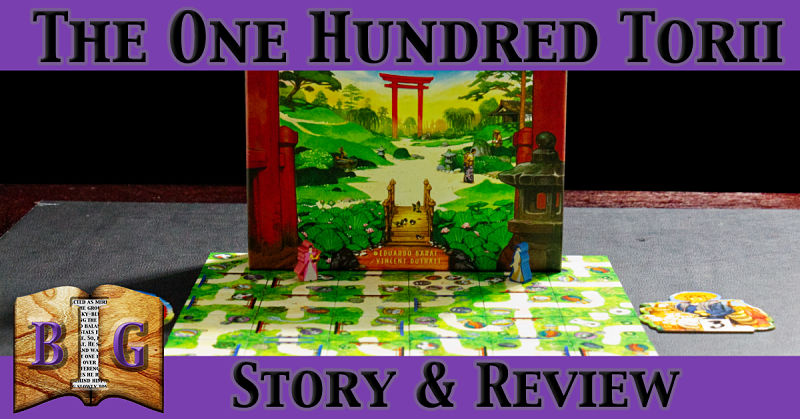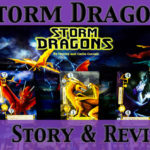*PLEASE READ* There are huge shipping concerns in the board game industry. The inability to secure shipping containers and passage for games (and toys in general) on behemoth ships is creating a shipping crisis, and is hurting publishers who just want to make fun games. As such, I am taking this opportunity to review a game (The One Hundred Torii) from Pencil First Games that is currently in stock at their online store. This way, we are able to promote their available games while they wait for their shipments of other games to arrive.
As a disclosure, I wrote this review of The One Hundred Torii a while back, but it is no longer on the website it was originally published on. This review has been updated to reflect my thoughts since first reviewing it, and those updates will be noted by the word “UPDATE” and will also be in italics so you can tell what is new, and what is original. Nothing will be deleted, so you will be able to see how the game ages (even though it’s only been what, a year?). Likewise, this review will maintain its original format, so it will look a bit different from the other reviews I normally post. Pictures are also coming from the original review. I was provided a complimentary copy of the game when I first reviewed it, so that disclaimer still stands. That said, I hope you take the time to check out The One Hundred Torii from Pencil First Games as you wait for the boat loads of other games to slowly make their way to you.
Journey before destination.
At a Glance: The One Hundred Torii
Designer: Scott Caputo
Publisher: Pencil First Games
Artist: Vincent Dutrait
Player Count: 1-4
Editor: N/A
Suggested Age: 8+
Playing Time: 45-60 minutes
Theme: Japan, Gardening, Journey
Mechanics: Tile placement, set collection
UPDATE: The One Hundred Torii Intro Story: The Tranquil Garden
Come where birds reside,
Sep’rate sacred and profane;
Torii divide.
The garden wakens
And visitors amble through.
Arch’d bridge crosses stream.
Meandering paths,
Sekimori ishi lead
To guide the trav’ler.
Purify the heart,
Crouch low at tsukubai.
Be humble, be clean.
Lanterns light your way,
From ground to air and spirit.
Keep your light glowing.
Protecting the shrines,
Inari bring messages
From a kind kami.
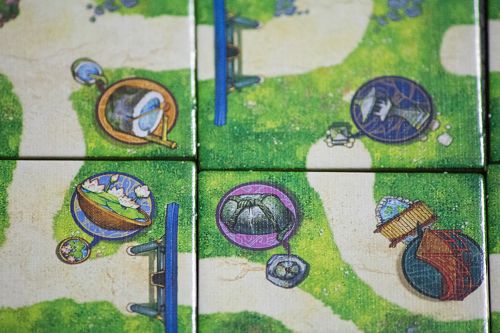
The One Hundred Torii Review
I don’t know where to begin with this, so I’ll just say what I’m thinking: I want to play The One Hundred Torii again! And again and again and again! Not only is the art striking (it’s so nice!), but the gameplay is satisfying, with both easy-to-learn rules and some deep thought while playing. There’s your tl;dr.
When describing The One Hundred Torii to others, I always compare it as a cross between Tokaido and Carcassonne. Tokaido, because you’re trying to enjoy your journey, and Carcassonne because you’re laying tiles and building routes. There are also characters that players can hire to give them perks or advantages. I’ll explain this further down when we discuss the finer details of things, but the combination of mechanics is like having a tall glass of eggnog—delicious, smooth, and somewhat fattening.
Really though. I was super impressed with The One Hundred Torii from the time it came to my doorstep until now (UPDATE: I still am). The first thing that really caught my attention were the punch boards—when I was about to toss them. They came with full art, even on the wider spots that would normally be blank. I almost didn’t throw them out because they looked so good. Almost. It’s that attention to detail that clues me in to a game that has been developed with care and passion.
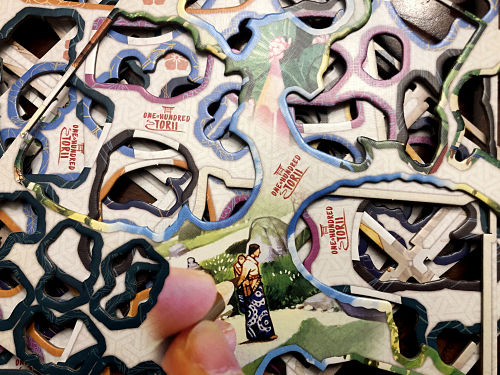
Moving on to the rule book to learn how to play, that same care was also noted. As a rule book editor, I am probably more critical than most with what I see inside those booklets. However, the rule book for The One Hundred Torii was excellent. Easy to navigate, easy to understand, examples where they were needed, and so on and so forth. The solo rules were likewise easy to understand, and located in a spot that made sense. And—get this—not only did the rule book teach me how to play (innovative, I know), it also contained a few good pages on the history aspect of the game. This includes why the landmarks are important, what they mean, and other things. Tell you what, I wish all games that portray some aspect of the world’s history did something like that, even to a lesser extent. I mean, it’s not bad that they don’t, but it is certainly a welcome bonus that this one does.
UPDATE: Continuing to speak on the rule book, I am impressed that Pencil First Games used historical and cultural consultants. I love that they put that effort into making sure their game was historically and culturally accurate. Honestly, this is something I think all publishers should do when publishing a game based on history and when involving other cultures. Major props to Eduardo Baraf and Pencil First Games.
Moving past the rule book to actually playing the game was, simply stated, quick and easy. The mechanics of the game are easy to remember, but the amount of brain power needed to maximize each turn increases as the game progresses. It is a wonderful feeling to not struggle through the game while learning it, and being able to adapt as the game progresses. Final scoring only takes a moment, and everything is streamlined.
If you’ve read this far, it’s apparent what my thoughts are of this game. I love it. It’s great, and the solo variant is just as wonderful. But, if you need more convincing (one way or the other), let’s dive into the details, shall we?
Setup
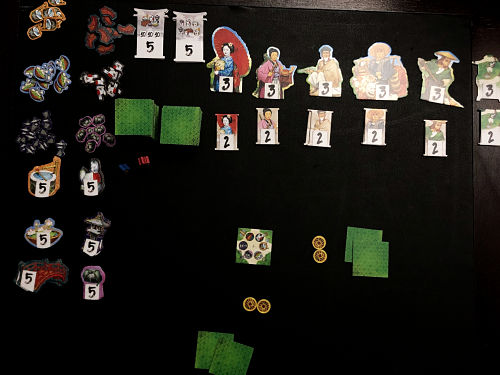
The longest part about setup is separating all the tokens. Fortunately, little baggies are included in the game, so that makes organizing the small landmark tokens much easier. Set aside the various character tokens and organize them by type, as well as the five-point landmark markers, large three-point character cutouts, special scoring bonuses, and the like. Place the starting tile (with the red back with all six landmarks on the front side) in the middle of the table, shuffle the tiles and stack them (removing a certain number from the game, depending on player count), give each player two tiles each and two coins, and you’re ready to go.
The One Hundred Torii Gameplay
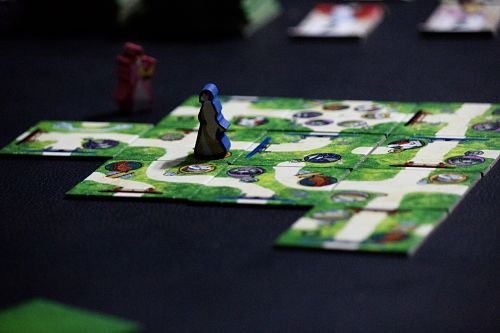
Players alternate turns utilizing character abilities, placing tiles, and collecting monument tokens throughout the garden. The game ends when the last tile has been taken, and then everyone—including the player to take the last tile—gets one more turn. Score is calculated by having monuments tokens of five or ten, by using character abilities one, two, or three times, or by creating enclosures (i.e. the path is an infinite dead end). The player with the highest score wins.
At the beginning of the game, turns can go fairly quickly, as the garden isn’t very big yet. First, the active player has the option to activate a character ability by paying one or three tokens (coins or landmarks). Once paid, that player collects that character’s cutout and places it in front of them to show they have two points. If that character gets used again, it is flipped to show it is now worth four points. If that character is used a third time—and no other player has used that character’s ability three times yet—that player will take the three-point bonus cutout. Only one player can get the three-point bonus from a character, so it’s first come, first served.
Of course, you may opt to not use a character’s ability, and that’s fine. After the character has been used (or not, as the case may be), the player chooses one of the two tiles from their hand and plays it next to an already-played tile. After playing a tile, the player then draws another one from the stack so they still have two tiles in their hand.
Placing a garden tile next to another one will connect paths and make the garden larger. Each tile has a landmark token on it (sometimes two). The player will get one landmark token as shown on their tile (of their choice if there is more than one landmark symbol) if the symbol on the tile they just played connects to another landmark of the same type somewhere else down the path. The patch chosen to the second landmark symbol is always the shortest distance from the tile that was placed.
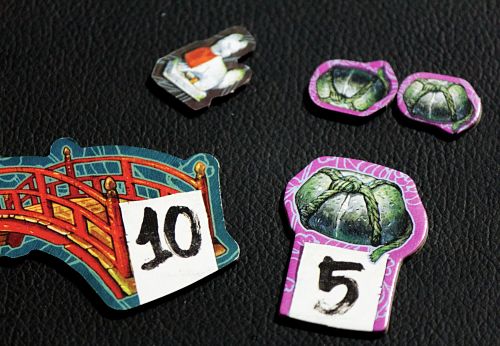
There are many torii, or gates, on the tiles, and passing through these torii will grant bonuses. For example, each red torii you pass through gives you another landmark token that matches the one on the tile you placed. Going under a blue torii gives you a different token than the one shown on the tile you placed. The longer your path from landmark to landmark, the more torii you can potentially pass through, and the more tokens you can acquire. That is a big part of the strategy, as going from symbol to symbol only nets you one token.
Once you have five tokens of a specific landmark, you trade them in for a larger token of the matching landmark, placing it in front of you with the “5” point face up. That five-point landmark token cannot be exchanged for character abilities, so you’re stuck with those points (which is a good thing to be stuck with). Once you have five more small tokens of that type, exchange them to the bank and flip the “5” point side over to show the “10” point side. You can never go higher than 10 points for a landmark, and you may only have one large point token per landmark.
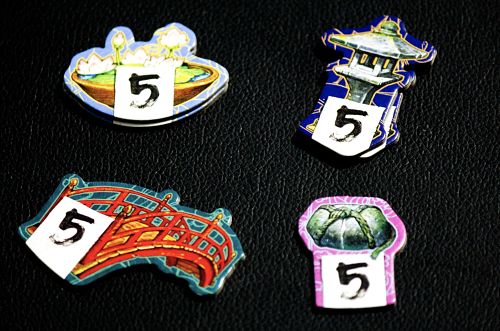
There are a couple bonus scoring conditions as well. If you are the first player to collect the “5” point landmark token from all six landmarks, you take the top tile from the corresponding bonus pile, which gives you an additional five points. The next player to reach that goal takes the next one, which gives three points. The other bonus goes to the first two players who collect three “10” point landmark tokens. Again, the first player to do so gets five bonus points, and the second player gets three.
Once the endgame is triggered, play your final turns then count the points. Highest score wins.
Thoughts on Gameplay
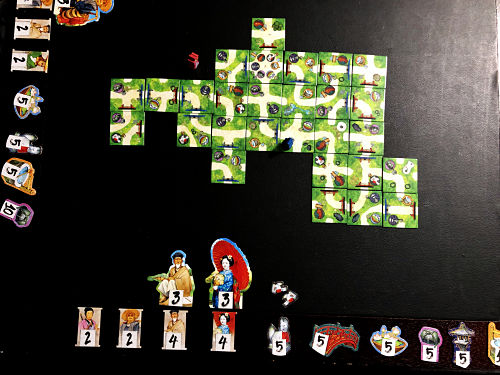
The core mechanics are simple to teach and to remember, which is brilliant. As the game progresses, the mechanics don’t change, but your paths will. Because you want to collect as many landmark tokens as possible in a turn, you’ll want the longest route from point A to point B. You might have to settle for fewer, but paying to use character abilities can overcome some problems. For example, the Poet gets placed on any one landmark symbol in the garden. Until the Poet is used the next time, he stands there, essentially blocking that landmark from view, allowing you to skip by it and prolong your path. Of course, paying tokens to use characters needs to be done with care, since you are trying to collect tokens to score points.
There is some wonderful consideration to each turn, and while it is a simple game to learn, it is in no ways a simple game to play. I think one of the biggest strengths of The One Hundred Torii is the growing complexity as the game progresses. It is simple, elegant, and engaging through the end.
UPDATE: I find myself nodding in agreeance to everything I just said. Looks like my thoughts remain the same.
UPDATE: I should also mention my thoughts on the solo variant. It’s great! It pits you against an automa player who follows different rules than you do, but the solo experience doesn’t waver from the multiplayer experience much at all. And the solo variant looks to have been designed as part of the game, rather than an afterthought. Even if it was an afterthought, they did a good job on it, so I’m happy they gave it life.
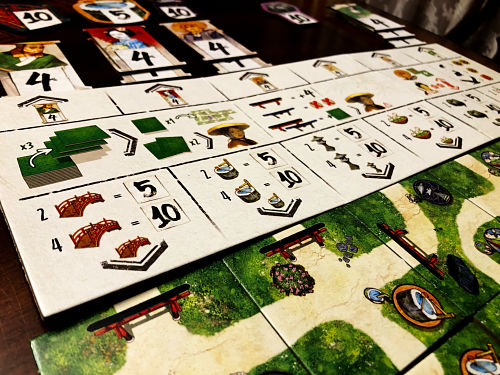
Theme and Mechanics
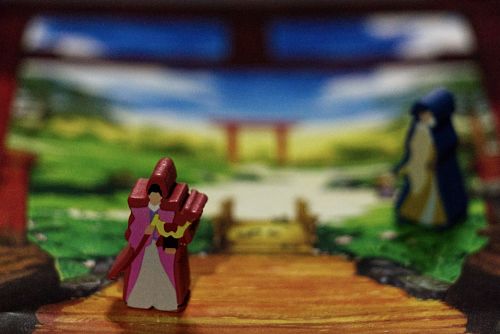
The theme of The One Hundred Torii is that of ancient Japan, taking the scenic route through a garden in order to find inspiration from your walk. The theme is very similar to that of Tokaido, but the mechanics couldn’t be more different.
The main mechanics are tile placement with route building. While these form the basis of your turns, set collection and special character powers also come into play. I enjoy the mechanics associated with the theme. I think they work together nicely and do provide a somewhat relaxing experience. The mechanics of the game aren’t difficult to grasp, and therefore don’t take away from the simple nature of the theme. Yet, as mentioned, the mechanics allow for some serious thought to go into your turns, which allows the game to stay fresh play after play.
UPDATE: I said it provides a “somewhat relaxing experience.” And it’s true. But I should also mention that, as the game progresses, the thought going into your tile placement gets more and more difficult. Relaxing, yes, but also stimulating.
Artwork and Components
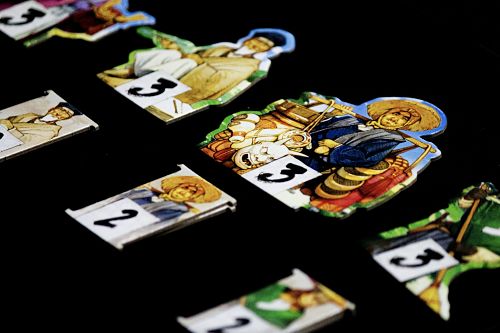
The artwork is wonderful. Even the punchboards had full art. I almost couldn’t make myself toss the empty punchboards, but I relented in the end. Everything about the art gives a traditional Japanese feel to the game. The marriage of art and theme is a match made in heaven.
The components are good quality cardboard. Tokens and tiles are your regular thickness and I have no issues with them at all.
The Good
- Beautiful art
- Easy to learn
- Deep decision making
- Always fresh, game after game
- Solo variant is smooth and maintains the feel of the game without feeling forced
- Two mini-expansions available
The Other
After playing The One Hundred Torii many times, I can honestly say I haven’t found anything not to like about it. The things that people may not like about this game would be personal preference, and not a flaw in the game itself.
UPDATE: This still checks out. I have nothing to add to this (other than that I have nothing to add…).
Final Thoughts on The One Hundred Torii
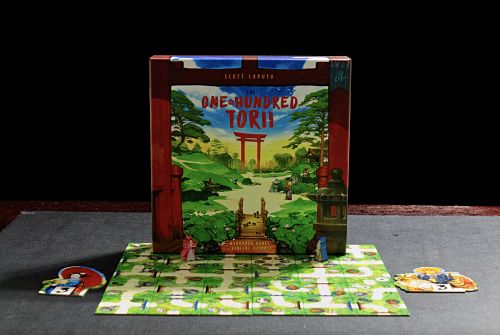
I am in awe with The One Hundred Torii. From looking at it initially, it looked like a good game. But I had no idea how good it actually was! From the easy-to-learn rules to the deeper thought for maximizing output, The One Hundred Torii will undoubtedly be heralded as a classic as it continues to stay relevant year after year. There’s something special about this game, and while I could gush about it all day long, it’s up to you to discover what makes it so special. The One Hundred Torii is beautiful, both artistically and mechanically. There’s a lot to like here, and I would recommend it to anyone, from new gamer to seasoned veteran. Come see for yourself.
UPDATE: I’d like to add my final thoughts again, now that I’ve had the chance to play The One Hundred Torii even more, and it’s been allowed to settle a bit longer. It still checks out. I still absolutely love playing it. I’ve taught it to others since writing this review originally, and they have also expressed how good the game is. I stand by my original comments that The One Hundred Torii is a wonderful game, and really should be given the spotlight more often.
Players Who Like
Fans of tile laying games such as Carcassonne and Isle of Skye will appreciate the fresh take on a classic mechanic. For those looking for a game that’s easy to teach and learn yet provides thoughtful decision making, The One Hundred Torii fits the bill. And, if you’re a fan of the traditional Japanese culture, this one will have you feeling at home in no time.
Check out The One Hundred Torii and Pencil First Games on Facebook, Instagram, Twitter, YouTube, and their website.
Read short fiction inspired by board games at Board Game Immersion’s stories page!

